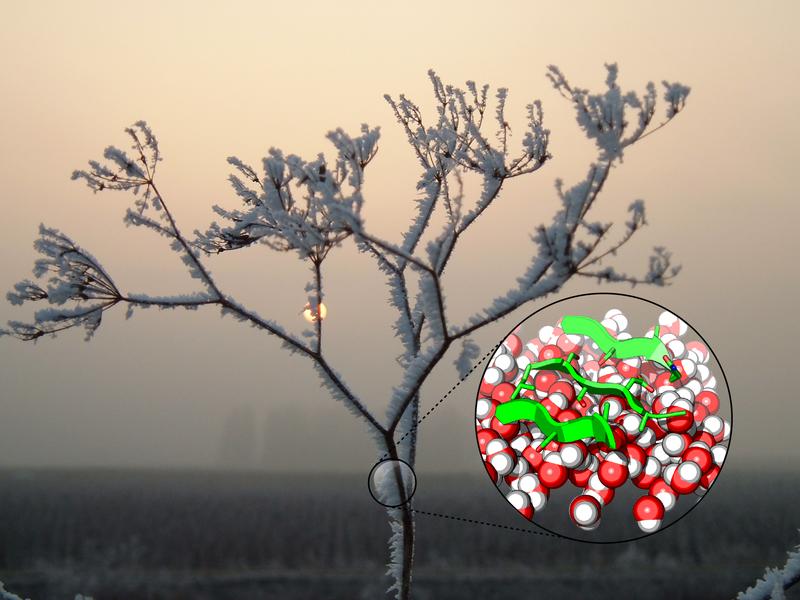

Ice crystals: Max Planck researchers discovered that certain bacteria can affect the ordering and the dynamics of water molecules in water droplets.
Graphics and collage: MPI for Polymer Research, photo: R. Eckl
The freezing point of water is anything but a clear subject. Small droplets of the purest water only freeze at minus 37 degrees Celsius. Crystalization nuclei such as bacteria with ice-forming proteins on their surface are required for ice crystals to develop at just under 0 degrees Celsius.
Researchers at the Max Planck Institutes for Chemistry and for Polymer Research have now elucidated the molecular mechanism how proteins congeal water molecules. According to the researchers, the proteins create ordered structures in the water and remove heat from the water.
The findings not only help to facilitate a better understanding of the conditions under which frost damage occurs on plants. Since the bacteria are also airborne in the atmosphere, where they promote the formation of ice crystals, they also play a role in formation of clouds and precipitation – a major factor of uncertainty in weather and climate forecasts.
A water droplet never freezes at 0 degrees Celsius. Water forms ice only at the temperature which is commonly known as freezing point, if it is in contact with large surfaces with many and large ice forming parts – for example in a vessel or a sea. It has been known for some time that ice formation in water droplets is promoted by bacteria by specific protein molecules at their surface. Until recently, however, the molecular mechanisms responsible for this phenomenon have been unclear.
Max Planck researchers have now unraveled the interactions between water and protein molecules at the bacterial surface. A team around Tobias Weidner who heads a research team at the Max Planck Institute for Polymer Research and Janine Fröhlich-Nowoisky, head of a research group at the Max Planck Institute for Chemistry, shows how ice-active bacteria influence the order and dynamics of water molecules.
Together with American colleagues, the Mainz researchers have reported in the latest edition of the scientific journal Science Advances that the interactions of specific amino acid sequences of the protein molecules generate water domains with increased order and stronger hydrogen bonds. Additionally, the proteins remove thermal energy from the water into the bacteria. As a result, water molecules can aggregate into ice crystals more easily.
Ice-active bacteria are of great importance to scientists from a variety of different perspectives. On the one hand they can cause frost damage on the surface of plants. On the other hand when carried by wind into the atmosphere, they can trigger as crystalization and condensation nuclei the formation of snow and rain and thus influence the hydrological cycle. The spread of ice-active bacteria and other biological aerosol particles in the atmosphere and their impact on the formation of clouds and precipitation is a much-debated topic in current climate and Earth system research. Findings about the ice forming effect of bacteria can help to better understand their role in the climate system.
To understand how bacterial proteins stimulate the formation of ice crystals, the researchers concentrated on the ice-active bacterium Pseudomonas syringae. This bacterium can trigger the formation of ice in water droplets beginning at -2 degrees Celsius, while mineral dust usually triggers the freezing process only below -15 degrees Celsius. Due to their high ice nucleating ability, devitalized Pseudomonas syringae are used for the production of artificial snow in the commercial product “Snomax”.
The scientists utilized the so-called sum frequency generation spectroscopy for their studies. By use of laser beams this technology allows the investigation of water molecules at the bacterial or protein surface.
Thanks to the new findings it appears possible to imitate the bacterial ice nucleating mechanism and make it usable for other applications. “For the future it is conceivable to produce artificial nano-structured surfaces and particles to selectively influence and control the formation of ice,” says Tobias Weidner.
Encouraged by the positive results, the two Max Planck research groups want to extend their cooperation. “We plan to examine the ice-nucleating proteins in isolated form. Currently, we are still analyzing whole bacterial cells and cell fragments. Additionally, we want to extend the analyses to fungal ice nuclei,” explains Janine Fröhlich-Nowoisky, whose working group specializes in the characterization of biological ice nuclei and has an extensive collection of both ice-active bacteria and cultures from ice-active fungi available.












